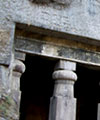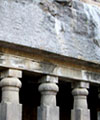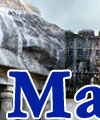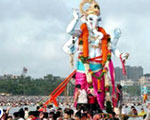|
Nasik
Temples
[ Panchavati | Kalaram mandir | Naroshankar Temple | Sundarnarayan Temple | Godavari Temple | Akshardham | Gondeshwar Temple | Modakeshwar | Main Road Ganapati | Khandave Ganapati | Tilya Ganapati | Varad Vinayak | Dholya Ganapati | Navshya Ganapati | Shitaladevi Temple | Balaji Mandir | Murlidhara Temple | Kapurthala Chatri | Katya Maruti | Panchratneshwar | Vitthal temple | Muktidham | Someshwar | Bhagur | Saptshrigi Gad | Bhakti Dham | Shree Kapaleshwar Mahadev | Shree Ved Temple | Dutondya Maruti | Trimbakeshwar ]
Panchavati
River Godavari flows through Nasik and its Northern part is called as Panchavati. It is said that lord Shri Ram and Sita along with Laxman stayed at Panchavati for some time. Thus Panchavati has gained holy importance. There are five Banyan (Vad) trees and hence the area is called Panchavati. Nearby is Sita Gumpha (cave) where Sita is said to have stayed for some time.
- Sita Gumpha
The Gumpha (i.e. Cave) is near the five Banyan trees in Panchavati.
Sita Gumpha is at a distance of 2 km from Central Bus Stand. It is situated at the western side door of Kalaram Temple.Lord Rama's wife, Sita dwelled at this place and King Ravan abducted her from this place. The Shiv linga that she worshiped is still there in the gumpha.There are five Banyan trees in this area and thus called "Panchvati".
One can enter the cave with the help of a very narrow staircase. The cave has the idol of Shree Ram, Laxman and Sita. To
the left, one can enter into the cave having the Shiva Linga. Devotees believe that Ravan kidnapped Sita from the same place.
- Ramkund/Gandhi Memorial
The most important place in Panchavati is Ramkund. It is so called because Lord Rama is believed to have taken bath there. Mortal remains (Asthi) immersed in this kunda, are immediately absorbed in the water. A dip in this sacred kunda is considered very pious. Situated nearby is Gandhi Lake (Talav) having a memorable monument made out of white marble, in memory of the Father of the Nation. The ashes were dropped in Ramkund after Gandhiji passed away on 30th January 1948. Mr. Nehru was also present on this occasion.
Top
Kalaram mandir
Another important temple is that of Kala Ram. This temple was built by Peshwas. There are great processions and utsav on Ramnavami, Dasara and Chaitra Padwa (Hindu new year day). The specialty of the temple is that it was built with black stones.The stones were brought from Ramshej 200 years ago. It took 23 lakhs of rupees and 2000 workers to build the temple in 12 years. The apex of the temple is made up of 32 tons of gold. In 1930, Dr. Ambedkar performed Satyagraha, to allow the entry of Harijans into the temple.
The Kalaram temple is an old Hindu shrine dedicated to Rama in the Panchavati area of Nasik city in Maharashtra, India. It is probably the most important Hindu shrine in the city. Thousands of devotees visit it every day.
Top
Naroshankar Temple
Situated in Panchavati area about 2km from Central Bus Stand, on the bank of river Godavari - fondly called as ganga by Nasikites - is Naroshankar Temple of Rameshwar built by Naroshankar Rajebahaddur in 1747. The architectural style of the temple is called "Maya". It is one of the most beautiful pieces of architecture of the 18th century. The main temple is on a platform. Rather than inside of the temple, sculpture on the outer part is stunning. It has rows of striking designs. One layer is of decorative lacework. The next one is that of peacocks holding bead garlands. In four directions are statues of the saints in Padmasana. There is also an assembly of animals - tigers, monkeys,elephants etc. This depicts that Hindu culture is not limited only to human beings but also has relation with birds, animals, trees, and nature in general.
The temple is surrounded by 11 feet fortification. In its four corners are umbrellas - called "Meghadambari" or "Barasati". One of them was washed away by Godavari floods and only three are existing presently. The fortification also centres a "Bell house" in the front part. The famous bell , called "Naroshankar Bell" is fixed there. The bell is a victory memorial over Portuguese. The Maratha Ruler Bajirao Peshwa's younger brother Chimaji Appa won the fort of Vasai against Portuguese. The famous knight of Peshwas - Mr Naroshankar Rajebahaddur played a critical role in this war. After winning the fort, Vasai Portuguese Church bell was removed, marched on elephant till Nasik with great celebration and offered to Naroshankar as a medal - an award for his bravery. It is made of bronze, with six feet diameter. The year engraved on it is 1921. The bell jingle can be heard up to 5 miles, it is said. This bell and its ringing is so famous that a phrase is coined after it in Marathi. If a woman is talking in a very high pitch, she is called "Naroshankarachi ghanta".
Top
Sundarnarayan Temple
Sundarnarayan temple is situated at the corner of Ahillyabai Holkar Bridge. The story goes like this : Vrinda Devi was a very pious and faithful wife of Jalandar - a wicked demon. Jalandar, a mighty crook, was the devotee of Lord Shiva. Pleased with his prayers and impressed by Jalandar's wife's chastity, Lord Shiva gave him a boon that made him immortal. With this boon, Jalandar became vicious and started creating havoc on earth. He not only troubled human beings, but also disturbed the Gods. He even ventured to pick up a quarrel with Lord Shiva himself. It became necessary to eliminate him which was contrary to the boon given by Lord Shiva. The only way out was to suspect Vrinda Devi's chastity. For this task Lord Vishnu duplicated himself to look like Jalandar and lived with Vrinda Devi. Thus her chastity was suspected and the boon given to Jalandar was withdrawn and he was destroyed. When Vrinda Devi came to know of the trick played by Lord Vishnu, she got furious and cursed Lord Vishnu. His attractive body turned black due to the curse. Lord Vishnu took a holy bath in the river Godavari and regained his complexion. Since he became beautiful again, - the Lord is named as Sundarnarayana. Sundar in Marathi means beautiful.
The Sundarnarayan temple is built by Gangadhar Yashwant Chandrachud in 1756. The entrance of the temple is to the East. The two Mandaps may be small but their architecture is attractive and the round dome is made by little ornamental cordons. The arched recesses are impressions by Mughal style because during the Mughal Regime many temples were demolished by Muslims and graveyards were built in their place. The main deity is of Lord Vishnu - alias Narayana . To his left and right are Laxmi and Saraswati respectively. Fine design is carved on the stones of the temple. On the road leading towards Godavari River there is pond named Badarika Sangam Pond. It is said that the king of Devgiri bathed and performed rites in this pond. We also find a mention of this pond in the holy book Dnyaneshwari. One remarkable thing about this temple is that it is built at such an angle that on 21st March, rays of the rising Sun first fall exactly upon the idols.
Top
Godavari Temple
The Godavari Temple was built by Elder Madhavrao Peshwa's mother, Gopikabai in 1760. This temple is open for devotees only during the period of Kumbhamela (once in 12 years) for 13 months. It is also called Ganga Temple.
- Holy places at River Godavari
The places where a holy dip can be taken in the river Godavari are: Govardhan Tirtha, Pitru Tirtha, Golan Tirtha, Brahma Tirtha, Runamochan Tirtha, Krishna Tirtha, Papnashan Tirtha, Koti Tirtha, Agni Tirtha, Shukla Tirtha, Aruna Tirtha, Surya Tirtha, Chakra Tirtha, and Ashwini Tirtha.
Top
Akshardham
Near Tapovan, on Agra road the Swami Narayan temple or Akshardham is located. Years ago, this was Bramhachari (Bachelor's) Ashram. The trustees of the temple run a school in the Sanskrit medium.
Top
Gondeshwar Temple
The Gondeshwar temple is a very beautiful temple built in the Hemadpanthi style of Architechture. During the Adilshahi rule in Maharastra, Ahmednagar was the capital. One of the pradhans (minister) of Ahmednagar was Hemadpanth who popularised a typical style of construction using locally available black stone and lime. This style became very popular and came to be known as the Hemadpanthi style. The Gondeshwar temple is one of the few structures of this style still in good shape.
Top
Modakeshwar
This ancient temple of Ganapati facing east is situated at Asarachi Ves on the road from Ramkund to the cemetery. The idol has an original shape of a modak and hence is called Modakeshwar. According to a legend, modaks used to be found in this temple. The temple owner Vilas Kshemkalyani's ancestor Keshavrao Kshemkalyani saw in dream a Ganapati at this place. When he came to this place, he really found a swayambhu Ganapati. Since then his family has been looking after the idol. Nasikites have great faith in its divinity and it is believed to be answering to their prayers. Ganesh festival is celebrated here on all ten days in Bhadrapada. The Modakeshwar temple has lent holiness to this area which otherwise looks ghastly because of the cemetery and a long stretch of ground along the riverbank. Now this are is humming with a lot of activity.
Top
Main Road Ganapati
This temple, which celebrated its centenary seven years ago, belongs to Damodar Vishnu alias Damu Anna Dongare. Born in a family of scholars in Vedshashtra, Damu Anna was very knowledgeable in medicine and also in music - he himself was a tabla player. The property on which this temple stands today, belonged to Damu Anna and there was a lovely garden watered from the well in the backyard. Once during meditation he sensed a divine directive to build a Ganapati mandir. Same night, he caught a burglar trying to break open a jeweller's shop across the street. The jeweller offered to give a prize of Damu Anna's choice. Damu Anna asked him to donate a marble deity of Ganesh and the jeweller very happily complied with the request. Thereafter this temple was constructed where Damu Anna's love for music is nurtured even today. Bhadrapad and Maghi festivals are celebrated as also every Chaturthi, concerts are held in the temple. As you turn from Mahatma Gandhi Road to Main Road near Ravivar fountain, you come across this temple on your left. Long and wide main hall, a pretty idol and old glass chandeliers impress you instantly. The Ganesh idol faces the east.
Top
Khandave Ganapati
This 150-year old temple is in Somvar Peth in Nasik. The Ganesh idol is carved out of a single boulder but is not visible because of shendur applied all over the deity. This 6-feet tall temple along a wall belongs to Madhukar Murlidhar Khandave. Earlier this idol was in Khandave's house. Later Jahangirdar Khedkar donated this place to Madhukar's great grandfather and a wooden temple was built. Over a period, a stone temple was set up. Devotees believe that this Siddhi Vinayak fulfills their wishes and hence they offer modak, gulachi bheli, silver durvas etc.
Top
Tilya Ganapati
As you go from Sandava across Rokdoba Hanuman temple near Modakeshwar towards Panchavati, you come across this temple with twenty steps at Ganeshwadi. The legend behind this temple is that the Ganesh idol grows by the size of a sesame (til) on every Sankrant (G) day and hence it derives name Tilya Ganapati. Also this Ganesh temple lends the name Ganeshwadi to this area. This east-facing deity was found while digging the foundation of Damodar Dagdusheth Sonar's house. His eighth generation, which has adopted a surname Bhadakwade is now looking after the idol and the temple. This temple was built hundred years before the present day Kala Ram temple. A big fare is held here on Tili Sankrant day and old Nasikites attend it without forget. Bhadakwade family members themselves perform puja as there have been instances of calamity befalling the family whenever there was a break in the tradition of family members performing puja.
Top
Varad Vinayak
Ahilya Devi Holkar installed this Ganapati on Thursday, Jeshtha Shudh Dwadashi in 1708. The famous Ahilya Ram temple of Nasik is adjacent to this temple of Varad Vinayak. Kamare family living just across the temple is the devotee of Varad Vinayak. Kamares built this temple in 1969 as per the divine dream of one of the family members, it is said. The temple is owned by Narayan Sitaram Kshemkalyani who offers puja every day. Festivals are held during Bhadrapada and Magh. This east-facing temple is situated where the slope from Kala Ram Temple to Ramkund ends behind Kapaleshwar temple.
Top
Dholya Ganapati
This Peshwa time Ganapati is located near the Ashok Stambh in the central Nasik. Conventionally, temples of Maruti, Ganapati, Bhairavnath were set up beyond the limits of a city or village. According to this convention, the Nasik's inhabitation ended near this temple. The deity is lovingly called Dholya because of its impressive hugeness - aptly called Lambodar, Vishalkay etc. The temple is frequented by college students and is very crowded during the day. Gaikwad family looks after the idol and the temple.
Top
Navshya Ganapati
This Ganapati was installed by Anandibai during the period of Peshwa at Anandvalli on Gangapur road going towards Someshwar. Previously an independent village is now within Nasik city limits. Since this Ganapati answers to the offerings in prayers (navas), it is called Navshya Ganapati. Recently a local Shiv Sena corporator took the lead to renovate this temple. A small path dotted by trees on either side leads to the river and this temple on the slope near the riverbank is worth a visit. Godavari's huge river basin and green fields along the bank are so spellbinding that you don't feel like leaving this place. This naturally beautiful spot attracts film shootings too.
Top
Shitaladevi Temple
The temple is situated near the Goraram Temple. The devotees believe that the goddess Shitala cures diseases like Smallpox, Chickenpox etc. But now since smallpox has been eradicated and Chickenpox can be treated if fatal, the importance of this temple has lessened.
Top
Balaji Mandir
This temple, situated at the "Ramsetu" bridge near Sarkarwada, was built in 1771. The idols in the temple were found by Ganapatibuva Gosavi in the small village of Pannav-velli in Tamil Nadu. The Lord Balaji's crown is made out of gold embedded with pearls and diamonds. Balajiwale Trust looks after the maintenance of the temple.
Top
Murlidhara Temple
The temple situated in Goraram Lane, was built by late Shri Dadabuva in 1828. The temple has a very beautiful idol of lord Krishna with flute.
Top
Kapurthala Chatri
Between Gadage Maharaj Bridge and Ramsetu bridge, there is 30 feet high Kapurthala Chatri (umbrella) made of marble stone. In 1870, former king of Kapurthala (Punjab) died in Eden. The Chatri was built in his memory. In front of the Chatri is the Kapurthala Dharamshala.
Top
Katya Maruti (Hanuman Temple)
This temple of Hanuman towering to a height of idol is 11.5 feet, is situated near Laxman bridge, built in 1771, by Shri Raghunath Bhatt Karte.
Top
Panchratneshwar
Nearby is the Panchratneshwar temple buit in 1758. It has Shivalinga from the times of the Lord Shri Rama.
Top
Guru Gangeshwar Ved Mandir
The Ved Mandir was built with the aim of studying Indian culture and Ved and Puranas. A private trust of Mr Sarada founded the temple.The temple is the example of modern interiors built with Italian Marble. The entrance to the temple is very large and attractive with glasses and flood lights. Free training and education on Ved-Puranas is given to students from all over India. The temple contains the idols of Shriram, Laxman and Sita. Along with them is the beautiful idol of Guru Gangeshwaraji.
Top
Vitthal temple
On the way to Prin.T.A Kulkarni Educational Institute, is situated the Vitthal Mandir. The temple is dedicated to Vitthal and Rakhmai. Worshipped by devotees, the temple is a major attraction since it is very clean and spacious.
Top
Muktidham
Muktidham temple is situated in Nasik Road. Built by Late Shri JayramBhai Bytco, is magnificient peice of architucture, made with marble form Makran in Rajastan, and by Rajastani scluptors. Unique to this temple are eighteen chapters of Geeta written on the walls. You can also see the replicas of all the twelve Jiothi Lingas over here and also icons of all major Hindu Gods and Godesses. After visiting this temple every Hindu feels that he has visited all the four Dhams in India.
Other temples
Other beautiful temples are Gora Ram, Ekmukhi Datta, Advaiteshwar, Ardha Nari Nateshwar, Mukteshwar, Narkeshwar, Dutondya Maruti, Laxminarayan temple.
Top
Someshwar
On the way to Gangapur dam, tourists are fascinated by the beautiful nature spot called "Someshwar". There is a temple of Lord Shiva and Lord Hanuman on the banks of the river Godavari. The area is covered with greenery all over, with a pleasant climate. Tourists can take pleasure of swimming and boating in the river.Someshwar has been a favourite location for many a filmshootings. On the way to Someshwar, there is a village named Anandwalli. It is so named because Peshwas - Anandibai and Raghobadada, lived there for some time. The temple - Navasha Ganpati was built by them.
Top
Bhagur
Bhagur is the birth place of the freedom fighter, Swatantrya Veer Savarkar and hence it has gainedhistorical importance. There is also a beautiful temple of "Bhagur Devi". Bhagur is situated 3 km away from Deolali Camp.
Top
Saptshrungi Gad, Vani
Shree Saptshrungi Gad is situated at a distance of 60 km from Nasik.It is one of the most visited and religious places for pilgrims.As the temple is situated on a mountain, a regular bus service is provided from the foot of the mountain to the temple
Hindu calendar considers three and half days as highly auspicious. They are Gudipadwa - Hindu's New Year, Dushhera, Diwali and Akshaytritiya. Likewise dwelling places of Goddesses in Maharashtra are famous. Tuljapur where Tulja Bhawani dwells, Kolhapur, the dwelling place of Ambabhavani, and Mahur where Kulaswamini dwells. Saptashringa Garh where Goddess Bhagawati dwells is half as important as any of the earlier mentioned places of Goddesses in Maharashtra. Saptashringa means the mountain having seven peaks. It is around 55 kms away from Nasik. Nanduri village is situated at the foot of the Saptashringa Garh. The road to the temple is zig - zag and climbs around 11 kms till it reaches the top. In front of the temple there stands Markandeya Rishi's (sage) hill. The Saptashringa Garh is full of a variety of trees having medicinal worth. As per the story in the epic Ramayana, Hanuman carried the herbal medicine for wounded Laxmana from this hill. There are about 108 water reservoirs on the hill. They are called as Kundas.
Top
Bhakti Dham
Bhakti Dham is sitiauted near Dindori Naka, at a distance of 2km from Central Bus Stand. This place is renowned for various temples built in the premises and all religious rituals, pujas and vidhis are carried out in Bhakti Dham.
Top
Shree Kapaleshwar Mahadev
Situated at a distance of 1km from Central Bus Stand, this temple is one of the peculiar Mahadev Temples in Nasik.The most prominent aspect regarding this temple is there is no idol of Nandi in front ofLord Mahadev.Shravani Somvar(Monday) and Shivratri are the 2 days when pilgrims gather in large numbers in this temple.
Top
Shree Ved Temple
The Ved Temple,situated at a distance of 1.5km from Central Bus Stand, was built with the aim of studying Indian culture and Ved and Puranas. A private trust of Mr Sarada founded the temple.The temple is the example of modern interiors with Italian Marble. The entrance to the temple is very large and attractive with glasses and flood lights. Free training and education on Ved-Puranas is given to students from all over India. The temple has the idols of Shriram, Laxman and Sita. Along with them is the beautiful idol of Guru Gangeshwaranandji.
Top
Dutondya Maruti
This idol of Lord Maruti is placed on the bank of Godavari river near Ramkund. This idol has two faces on eithe sides.
Top
Trimbakeshwar
Trimbakeshwar is an ancient Hindu temple dedicated to Lord Shiva, one of the twelve Jyotirlingas. It is located in the town of Trimbak, in the Nasik district of Maharashtra, India. The source of the Godavari river, the longest river in peninsular India lies in the hills surrounding the temple.
Trimbakeshwar, which is 28 km (18 mi) from Nasik, Maharashtra, India. It is a religious center having one of the twelve Jyoterlinga of the world. The extraordinary feature of the Jyotirlinga located here is that it has three faces embodying Lord Brahma, Lord Vishnu and Lord Mahesh(Shiva). All other Jyoterlinga have Shiva as the main deity. The temple is known for its appealing architecture and sculpture and is at the foothills of a mountain called Brahmagiri. Godavari River originates on Bramhagiri mountain and meets to the sea near Raj Mahendri, AP.
This place is famous for lots of religios ceremonies(vidis). Narayan-Nagbali, Kalsarpa Shantik, Tripindi vidhi are done here.
Narayan-Nagbali puja is performed at Trimbakeshwar only. This puja is performed in three days. This puja needs a special dates to perform it. Some days are not suitable to perform this puja. This puja is performed for so many reason. If one has suffering from illness, going thru bad times, someone in family has killed Nag (king cobra). Or one is having a problem to have a kids or just you have everything and you want to perform some religious puja to have everything. The Trimabakeshwar town has around 100 Brahmin houses. But make sure you have the good Guruji doing your Puja.
Top
Information of Temples in Nasik city of Maharashtra
- India
|






